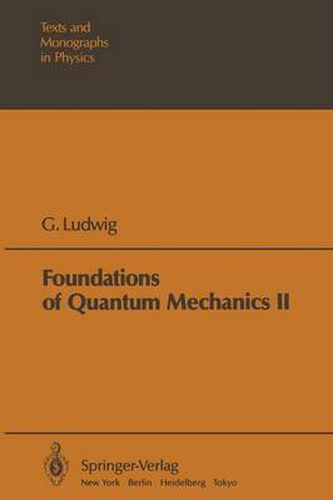Readings Newsletter
Become a Readings Member to make your shopping experience even easier.
Sign in or sign up for free!
You’re not far away from qualifying for FREE standard shipping within Australia
You’ve qualified for FREE standard shipping within Australia
The cart is loading…






This title is printed to order. This book may have been self-published. If so, we cannot guarantee the quality of the content. In the main most books will have gone through the editing process however some may not. We therefore suggest that you be aware of this before ordering this book. If in doubt check either the author or publisher’s details as we are unable to accept any returns unless they are faulty. Please contact us if you have any questions.
In this second volume on the Foundations of Quantum Mechanics we shall show how it is possible, using the methodology presented in Volume I, to deduce some of the most important applications of quantum mechanics. These deductions are concerned with the structures of the micro systems rather than the technical details of the construction of preparation and registration devices. Accordingly, the only new axioms (relative to Volume I) which are introduced are concerned with the relationship between ensemble operators W, effect operators F, and certain construction principles of the preparation and registration devices. The applications described here are concerned with the measurement of atomic and molecular structure and of collision experiments. An additional and essential step towards a theoretical description of the preparation and registration procedures is carried out in Chapter XVII. Here we demonstrate how microscopic collision processes (that is, processes which can be described by quantum mechanics) can be used to obtain novel preparation and registration procedures if we take for granted the knowledge of only a few macroscopic preparation and registration procedures. By clever use of collision processes we are often able to obtain very precise results for the operators Wand F which describe the total procedures from a very imprecise knowledge of the macroscopic parts of the preparation and regis tration processes. In this regard experimental physicists have done brilliant work. In this sense Chapter XVII represents a general theoretical foundation for the procedures used by experimental physicists.
$9.00 standard shipping within Australia
FREE standard shipping within Australia for orders over $100.00
Express & International shipping calculated at checkout
This title is printed to order. This book may have been self-published. If so, we cannot guarantee the quality of the content. In the main most books will have gone through the editing process however some may not. We therefore suggest that you be aware of this before ordering this book. If in doubt check either the author or publisher’s details as we are unable to accept any returns unless they are faulty. Please contact us if you have any questions.
In this second volume on the Foundations of Quantum Mechanics we shall show how it is possible, using the methodology presented in Volume I, to deduce some of the most important applications of quantum mechanics. These deductions are concerned with the structures of the micro systems rather than the technical details of the construction of preparation and registration devices. Accordingly, the only new axioms (relative to Volume I) which are introduced are concerned with the relationship between ensemble operators W, effect operators F, and certain construction principles of the preparation and registration devices. The applications described here are concerned with the measurement of atomic and molecular structure and of collision experiments. An additional and essential step towards a theoretical description of the preparation and registration procedures is carried out in Chapter XVII. Here we demonstrate how microscopic collision processes (that is, processes which can be described by quantum mechanics) can be used to obtain novel preparation and registration procedures if we take for granted the knowledge of only a few macroscopic preparation and registration procedures. By clever use of collision processes we are often able to obtain very precise results for the operators Wand F which describe the total procedures from a very imprecise knowledge of the macroscopic parts of the preparation and regis tration processes. In this regard experimental physicists have done brilliant work. In this sense Chapter XVII represents a general theoretical foundation for the procedures used by experimental physicists.